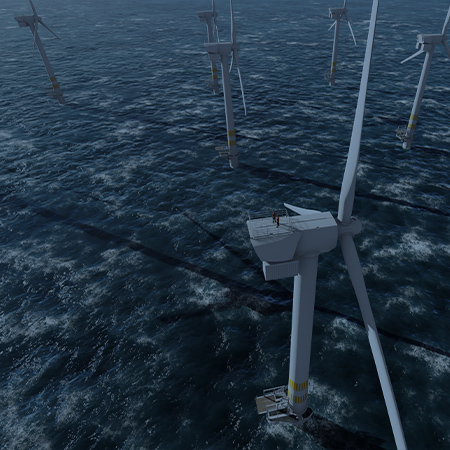Marsh Specialty is pleased to issue the April 2021 Energy & Power Newsletter considering the trends over the last quarter.
The energy and power insurance market provides solutions for companies operating within upstream, downstream, casualty, traditional power, and renewable energy. The articles consider the nuances and trends being experienced across the various sectors.
Legal Review

Legal Review
The UK Supreme Court has found substantially in favor of the Financial Conduct Authority (FCA) in the appeal of the business interruption test case, and dismissed appeals made by insurers.
The judgement (January 2021) included the following key points:
- Notifiable disease: cover will be available under all of the notifiable disease extensions considered by the Supreme Court for losses caused by the wider COVID-19 pandemic. This outcome extends to the QBE wordings under consideration which had been given a narrower application by the High Court.
- Non-damage denial of access: these extensions were construed more widely than they had been by the High Court, in particular:
- The public authority action necessary to trigger the cover need not necessarily have the force of law (such as government guidance or announcements); and
- The prevention of access to or inability to use premises need not be absolute, meaning that closure of a discrete part of a business could be sufficient to trigger cover.
- Causation and trends: consistent with the outcome of the High Court judgment, the Supreme Court did not find favor with the narrow arguments around causation and trends clauses advanced by insurers. In practical terms, on the wordings in issue, the findings of the Supreme Court will make it difficult for insurers to limit recovery on the basis that losses would have been caused in any event by the wider COVID-19 pandemic.
- Orient Express: the Supreme Court determined that the case of Orient Express Hotels v Generali was wrongly decided and that it should be overruled.
US Appeal Court concludes a seaman may be contributorily negligent when he is complying with an order from his superior.
The case involved a seaman who was injured while following an order to replace a chafed line during bad weather, and the court found equal fault to both the seaman and tugboat owner. The judge noted the tugboat owner was negligent because “there were safer times to issue the order to change the line”. The seaman was negligent because he failed to “watch his footing while replacing the chafed stern line” and did not “move the chafed stern line to a location on the boat where he would not have stepped on it”.
In appealing the decision, the seaman cited a similar case where the Appeal Court had found that “a seaman may not be contributorily negligent for carrying out orders that result in his own injury, even if he recognizes possible danger”. However, the Appeal Court found that the cited dictum (a remark, statement, or observation by a judge that is not a binding legal precedent) could not be applied in this case as the seaman was not following a ‘specific’ order. The court defined a ‘specific’ order as one that includes a manner and method, and does not make allowances for alternative action. The court upheld the finding of contributory or comparative fault by the seaman.
US Customs and Border Protection (CBP) ruling in relation to offshore wind energy projects on the Outer Continental Shelf.
In the US, the Jones Act is a section of the Merchant Marine Act (1920) which specifies that US flag ships must be used to transport cargo and passengers (coastwise trade) between US ports. For offshore wind energy projects, one of the first requirements is for scour protection material (typically rocks). In January, CBP ruled that the Jones Act applies to vessels discharging scour material to a ‘pristine seabed’ for projects on the Outer Continental Shelf. The CBP cited 2021 amendments to federal law (Outer Continental Shelf Lands Act 1953) which now expressly includes reference to “installations and other devices permanently or temporarily attached to the seabed, which may be erected thereon for the purpose of exploring for, developing, or producing resources, including non-mineral energy resources”. Going forward, the CBP may have to consider how the Jones Act will apply to offshore wind projects compared to oil and gas projects.
Demystifying Common Clauses

Demystifying Common Clauses
In this regular feature, we take a look at common clauses found in energy insurance that are often not well understood, and try to look at what their intentions are, and what they cover or exclude.
In this article we examine expediting expenses.
Many property damage policies contain a sub-limit for expediting expenses but what does this cover?
Expediting expenses coverage is similar to extra expenses coverage and is usually an extension to a gross earnings business interruption policy. It provides indemnity for costs incurred to continue the operations of the business, to a level that is as near as possible, to the level prior to a loss (such as renting temporary properties).
Usually the coverage is limited to reasonable and necessary extra expenses incurred by the insured, subject to an agreed sub-limit of liability. However, some forms of cover may be limited to the amount of business interruption claim saved by the action. For example, cover is applied if US$90 is spent to save a loss in revenue of US$100, but if US$110 is spent to save USD$100 of revenue, the claim is limited to US$100. It is sometimes possible to extend the business interruption section of a policy to include cover for ‘additional extra expenses’ (subject to an agreed sub-limit), if a business needs to spend more than it will save in order to continue normal business operations. For example, to avoid loss of market share. However, ‘expediting expenses’ differ from extra expenses as they are usually an extension to the property damage section of a policy.Expediting expenses clauses usually cover the expenses of temporary repairs, and costs incurred to speed up the permanent repair or replacement of covered property or equipment. This could include measures such as overtime or additional costs incurred for express or rapid transportation.
Unlike extra expense clauses, expediting expenses are not restricted to having to reduce a business interruption loss. However, expediting expenses will typically be subject to a sub-limit of liability.
The above is provided as a general overview of some of the coverage often provided by the aforementioned clauses. This is not intended to be an extensive and exhaustive analysis of the insurance coverage provided by such clauses. The comments above are the opinion of the Marsh Specialty only, and should not be relied on as a definitive or legal interpretation. We would encourage you to read the terms and conditions of your particular policy and seek professional advice if in any doubt.
If readers have particular clauses they would like us to consider including in this feature, or have any comments on the above, please contact john.cooper@marsh.com
Overview of the Insurance Market

State of the Market Overview
Insurance markets, like most commodity markets, are cyclical. The commodity in the insurance market is an insurer’s capacity to underwrite risk, and the limits they place on those risks.
Like all cyclical markets, pricing is driven by supply and demand - supply being insurers’ capacity, and demand being the limits of insurance companies want. Limited capacity leads to higher pricing, and additional capacity forces competition leading to lower pricing. At a certain point in a downward rating environment, insurers cut-back capacity or withdraw, enabling remaining participants to increase prices, which over time attracts new capacity. And the cycle repeats.
Clearly, this is an overly simplistic description of the insurance market cycle which is actually influenced by various complex, external factors, that impact available capacity and drive demand. Capital flowed to insurance markets following the financial crisis of 2007-08, because of record low interest rates and poor investment returns from financial markets. This increase in supply led to a softening of insurance markets across the board. For nearly a decade premium levels (rates) reduced year-on-year, and terms and conditions improved in buyers’ favour.
While capacity in the insurance markets has remained relatively steady over the last few years, overall loss levels in many sectors have gradually led to capacity withdrawals and the onset of a hardening market. This is characterised by premium increases year-on-year, tightening of terms and conditions, and in some cases, increases in deductibles, in insurers’ favour.
Sectors where overall premium values are not sufficient to cover the actual or prevailing losses, have seen year-on-year double-digit increases to “correct” the insurers’ book. However, despite this hardening market, rate increases in certain sectors, such as downstream property insurance, are decelerating as capacity levels stabilize. New entrants are returning to other sectors where demand is increasing however, at the same time some insureds are exploring alternative risk strategies such as self-insurance or the use of captives and mutuals. Typical of a hardening market, there are more restrictive terms and conditions for certain perils, such as lower sub-limits or absolute exclusions. Cyber exclusions in particular have gained traction with insurers, and unsurprisingly, the pandemic has led to the introduction of communicable disease exclusions on virtually all policies.
Energy Property Market Trends

Upstream Energy
Confidence is returning to the oil and gas industry as the oil price improves significantly from its 2020 lows. The January 2021 edition of this newsletter discussed the concept of a capacity pyramid for upstream sectors. There are now clear signs that insurers are competing for a bigger share of insureds with premiums of around US$10 million at the top of the pyramid. Here, increased capacity, increased competition, and the absence of significant losses in the first quarter, mean price increases by insurers are more difficult to achieve.
Confidence is returning to the oil and gas industry as the oil price improves significantly from its 2020 lows.
Discrepancy between insurers has stabilized and average increases of around 5% were seen over the quarter. However, conditions continue to tighten for smaller business at the bottom of the pyramid. This is due to historical inflation of premiums, poor claims records, and some insurers exiting the market when they are unable to secure minimum premiums in-line with their underwriting requirements.
There is increased interest in offshore construction from following markets, enabling easier completion of programs.
Overall, insurers have absorbed the minimum 10% treaty reinsurance cost increases that they have experienced previously. The insurance procurement outlook for upstream clients definitely looks brighter.
However, it is a different story for United States Gulf of Mexico insureds who buy named windstorm coverage. The market remains tight to hard, with no serious new entrants to challenge the major insurers. Treaty reinsurers have not responded to the excellent results that this class has generated over the years, allowing underwriters to continue to impose extremely high retentions.
The most positive outlook for deepwater assets is likely to be ‘as before’ premium pricing. For fixed shelf platforms, the reasonably priced capacity offered by cargo style underwriters is likely to contract following losses from Hurricane Laura in 2020.
Downstream Energy
Customers experienced improved offerings from the markets during the first quarter. Better loss experience through 2020, coupled with many years of continuous rate increases, and lower than expected reinsurance treaty costs, have seen insurer profit margins significantly improve. Rating levels are close to those of 2012, which some insurers consider a benchmark for sustainable underwriting. However, despite limited new capacity entering the sector, insurers generally, are targeting double digit premium growth in 2021.
The rollout of COVID-19 vaccine programs is beginning to accelerate project work, which will increase opportunity for construction and operational insurers.
Capacity from leading global insurers for downstream property is in the region of US$4.4 billion but with only 50% of that applying to ‘working’ capacity for business interruption and natural catastrophe (NatCat) risks. Business interruption volatility clauses are well established and will be more poignant as customer earnings begin to ramp back up. The rollout of COVID-19 vaccine programs is beginning to accelerate project work, which will increase opportunity for construction and operational insurers. A move back to physical risk engineering surveys (and away from virtual surveys) may be further away as travel is likely to remain restricted throughout the year.
There remains a meaningful difference on expectations between geographical markets but this will likely narrow as the year progresses. The principles of pandemic and cyber resultant damage clauses continue to be hotly discussed. And, we expect to see further scrutiny and evaluation of environmental, social and governance (ESG) issues within the sector.
As we move into the busiest transactional quarter of the year, the markets remain sensitive to both rate movement and loss impact. Substantive or higher frequency of large losses will provide the momentum for upward rate movement, whereas a continuing absence of 2021 loss activity, and increased capacity, will provide a tipping point in the current market cycle.
At the end of the first quarter, rate rises are expected to continue but on a quickly flattening curve.
Power
Traditional Power
Insureds with a clean loss record and no NatCat exposure, continue to experience straight-forward renewals with premium increases around 15-20%. Outside of the US, new insurers are entering the market, which will slow premium increases but may cause over placement and signing down issues on sought after accounts. This is perhaps aided by operators willing to accept higher retention levels, as insurers shift their focus from pricing, towards scrutinizing sub-limits, and tightening terms and conditions.
Virtual risk engineering surveys continue to play a vital role in keeping markets up to date.
Accounts or programs that include coal are still likely to see price increases as the trend for insurers to exit the class is likely to continue. The remaining shallow pool of insurers may use this as an opportunity to increase renewal rates. Therefore, the restructuring of programs and utilization of international markets is likely to become prominent.
The placement process is taking longer due to insurers reducing their capacity, and lead markets delaying the quoting stage to influence price. Road shows, recent engineering reports and a demonstrable commitment to continual risk management, are crucial to prevent tougher market conditions. Virtual risk engineering surveys have been well received by insurers, and in the current circumstances, will continue to play a vital role in keeping markets up to date.
Renewable Energy
During the last quarter, London markets saw an influx of new business, and new capacity, with three new specialist renewable energy insurers starting operations.This is in-line with general industry trends, as energy transition gathers momentum and insurers adapt to the evolving needs of clients.
London markets saw an influx of new business, as the energy transition gathers momentum and insurers adapt to the evolving needs of clients.
Existing renewable energy insurers continue to push for rate increases, to correct poor performance over a number of years. This varies significantly on a project-by-project basis, but even accounts with no losses, and no significant NatCat exposures, are seeing average increases of around 20%.
More positively, it seems that deductibles on renewal accounts have stabilized following corrections by underwriters during renewals in 2020. However, there are exceptions for asset portfolios that have reached the end of their warranty or long-term service agreement period. In these cases, there have been significant uplifts in retention levels as insurers look to limit their exposure.
Early engagement with markets via virtual roadshows and surveys is critical in preparing for renewals or expiry of construction insurances. There has been a significant shift in underwriters’ philosophy and requirements during the construction phase of projects.
Markets continue to tread carefully with respect to unproven or proto technologies and only limited coverage is available until components are tested to prescribed minimum requirements.
As wind turbine sizes increase in both onshore and offshore sectors, deductibles are also increasing to levels similar to the traditional power market. Insurers are taking an increasingly conservative approach towards wind projects following a spate of losses from repeated lightning events, or perceived contractor errors during the construction phase.
Competition in the offshore wind market is improving with the injection of new capacity by traditional oil and gas insurers looking to diversify into this sector. This shift is being driven by the decline in oil and gas production, coupled with increasing focus on ESG requirements.
Overall, the markets continued to focus almost exclusively on wind and solar, and the majority of renewable energy carriers in the London market have discontinued writing hydro, biomass or biofuels, and geothermal assets. Coverage for these asset classes remains available from the power and property markets, but the withdrawal of capacity has led to pricing challenges. Conversely, there is increasing interest in battery energy storage as insurers look to expand their portfolios into new growth industries. As investors and renewable energy developers diversity into the energy storage sector, so too will insurers looking for new revenue streams.
Terrorism
New capacity in the political violence and terrorism market has helped to keep rates stable. The riskier end of the spectrum, which includes pipeline exposure, assets damaged by recent riots and looting, and assets that require the full political violence perils in high aggregate areas, will see higher rate rises. The drone attacks in 2019 on energy and non-energy related assets in Saudi Arabia, are still influencing underwriters in that part of the world.
Energy Casualty Market Trends

Overview
For now, rates in this class seem to have stabilized, following the significant price corrections that occurred during 2020. However, insurers have indicated that rates may continue to rise, and the absence of any meaningful market alternatives may enable this to happen.
The reinsurance renewals during the first quarter were manageable, increasing about 5-10%.
However, there is frustration from clients about coverage changes to certain components. For example, wildfire coverage is being targeted in territories where the loss experience does not warrant it. There are similar, continuing restrictions for some midstream businesses.
There have been encouraging signs of investment for the energy liability sector, but no confirmed mainstream entrants yet. It is clear that, for buyers and brokers, the near future looks challenging, and the remedies of 2020 will need to be applied for some time.
Bermuda Casualty
As we head into the second quarter, there is cautious optimism that capacity has stabilized in some sectors but that won’t be known for certain until portfolios are reviewed after the heavy renewal periods. There have been two new market entrants and more are expected during the year. Pressure continues on rate correction, and the tightening of some terms and conditions. For example, communicable disease and cyber wordings are being adapted, there is a growing interest in climate change and ESG programs, and wildfire exposures continue to be monitored.
Marine Exposures

Energy Marine Exposures
The rapidly escalating pricing of the last few years has now settled into a more consistent and predictable pattern as capacity withdrawals, and syndicate closures, diminish. Despite this, most insureds are looking at low, double digit increases in the near-term.
Underwriters are disengaging with accounts that have a poor loss record, limited spread of risk, low premium level or deductibles that are perceived to be inadequate. On larger or better performing accounts, leading underwriters are balancing the interests of the following market, with the risk of losing a favored client. Often, following markets are only prepared to support a competitive lead-line with higher alternative pricing, and there can be high uncertainty about the final price until the end of the placement process. In this situation, accounts that have regularly changed insurers are unlikely to receive any preferential treatment.
Overall, focus continues on deductibles, with terms and conditions continuing to tighten, and the inclusion of increasingly standard clauses such as:
- Automatic identification system (AIS) operation clause which aims to detect whether a vessel enters the waters of sanctioned countries (a policy exclusion), or enters a high-risk area (a war breach exclusion requiring additional premium to reinstate coverage).
- Revised cyber clauses to clarify the issue of silent cyber coverage.
- Communicable disease exclusions to address pandemic type events.
Onshore Construction Market Update

Onshore Construction
The market is at a steady rate of change edging rates up, and limits down. There has not been a step change, or overreaction to treaty renewals, indicating that both treaty reinsurers and insurers are comfortable with their forward view. In global markets, there are signs the gaps between policy terms, conditions and pricing offered in London compared to other regions are narrowing.
Obtaining timely responses to underwriting submissions continues to be a challenge with renewals taking longer than many clients had become accustomed to during the soft market.
As wind turbine sizes increase in both onshore and offshore sectors, deductibles are also increasing.
In some areas, difficulty in securing a consensus on policy wordings is also taking time as there are marked variances in relation to cyber and communicable disease exclusions.
If there are no large losses, which have not been allowed for within insurers’ models, the market conditions could be nearing a plateau.
Regional Market Trends

Middle East
The Middle East market continues to follow global market trends where we see clear signs of increased appetite, especially in the downstream and power sectors. This is reducing market volatility in some areas where the pace of market increases are slowing in modest increments. These changes are not happening organically, and renewal planning needs early engagement with a much more detailed requirement for premium and claims data.
The shifting strategies of global insurers, which has defined the recent period of change in the Middle East market, have had both expected and unexpected consequences. With fewer international markets in the region for upstream, downstream and power business, there is a greater need for regional clients to partner with London and European insurers – a trend we identified in the January 2021 edition. However, there has also been a growing appetite from a handful of leading insurers in Asia to secure a portfolio in the Middle East. This is positive for clients seeking to expand the global market participation for their programs.
An unexpected, but positive, outcome of some international carriers withdrawing from the region, is the availability of talent that domestic markets can use to strengthen their underwriting teams. The growing talent in many of the international arms of the local cedants, as well as the managing general agents (MGAs), has improved their capabilities across energy, power and construction.
Asia
The first quarter of 2021 has seen a continuation of the market trends and conditions that existed in Asia towards the end of 2020.
In the upstream market, underwriters are maintaining their discipline and focus on portfolio profitability. However, they are also showing an increased willingness to retain existing accounts, which reflects the reduced activity across the industry. In an effort to reduce acquisition costs, renewal accounts are seeing rate increases alongside offers of prompt payment discounts and renewal incentive bonuses.
While offshore construction rates have increased significantly in recent years, appetite remains for new projects, especially where the estimated contract values (ECVs) are in excess of US$1 billion. However, there is a high level of scrutiny of the terms, and anything that veers away from the ‘market standard’ may require a global broking strategy to ensure that the required levels of capacity are available. Smaller projects, and those that are purely subsea focused, continue to incur higher rates and more restrictive conditions, reflecting the level of attritional losses seen in prior years.
The downstream market in Asia tends to react more slowly than the London market, and the hard market cycle regionally is continuing, influenced by the losses incurred during 2020. The market also remains slow, hampered by continuing work from home requirements. Allowing longer lead times to manage renewal negotiations remains important, in order to secure the most commercial terms available. On a positive note, the quantum of rate increases is starting to reduce, particularly for accounts with good loss and claims history. To date there have been no major regional losses in the downstream market in 2021, which would seem to favor a continuation of the downward rating trend.
In the power sector, insurers continue to seek rate increases for all renewals, with few exceptions. Insureds that have suffered losses, or who are exiting long term agreements, are often experiencing significant price rises. Coal-fired power risks, particularly those combined with NatCat exposures, are continuing to face significant capacity challenges. Some smaller, complex power risks, such as waste-to-energy plants or run-of-river hydro, are also challenged, with a general lack of market appetite resulting in limited capacity. Conversely, on programs where rates have moved to insurers’ levels of price adequacy, there has been moderation in the level of increases, with no changes to other terms and conditions.The claims trend from 2020 has continued into the first quarter with further losses in the power sector, involving several large machinery breakdown claims. While not yet fully materialized, these losses are sure to again focus insurers’ attention on risk quality and risk management.
An interesting fact which is representative of market conditions in Asia, is that almost all power placements have remained with their current lead insurers. Rarely have new insurers assumed the lead role, and often this has been necessary as the previous lead insurer has withdrawn from the power sector or is unable to continue to offer capacity due to a change in underwriting guidelines. This illustrates the continued focus by most power insurers on bottom line profitability rather than revenue growth.
Domestic markets in Asia remain competitive compared to international reinsurance markets, particularly for power or renewable energy risks that can be written within their local treaties. In some domestic markets, like Vietnam, Taiwan, and Korea, local insurers are having to fully assume power risks, as international reinsurers are unable to meet the competitive terms available locally. It is uncertain if this situation is sustainable over the longer term, particularly when the low power sector premium pools locally are impacted by losses.
Focus on: Business Interruption Insurance

Business Interruption Insurance: One Size Does Not Fit All
Business interruption (BI) insurance is a complex topic and even the most experienced risk professionals can find it difficult to navigate both the intricacies of cover, and the often onerous claims process.
In most cases, BI insurance is designed to compensate a business for its net loss of income as well as for any unplanned increases in operating expenses, such as the cost of using temporary facilities. While this may sound simple, getting it right is not straightforward for large industrial organizations. There are many variables in financial forecasting, and predicting reductions or increases in operating expenses in the event of property damage, often requires making the intangible, tangible.
If you aren’t confident in the specifics of how your BI policy mechanism works, it may be time to take another look.
Most ‘off-the-shelf’ BI coverages fall short in meeting the specific circumstances of energy and power operations – for such a wide range of usage cases it’s impossible to apply a ‘one size fits all’ approach. The rapid pace of growth in the renewable energy sector, the increasing interdependencies at multi-site facilities, and the sheer range of contractual arrangements across complicated energy value chains, have resulted in a mixture of approaches to BI coverage.
Aligning a BI policy mechanism with the actual commercial arrangements of a business is essential to ensuring adequate cover and a smooth claims process. Historical and forecast data – beyond standard accounting metrics – is critical, but so too is aligning calculations with the basis specified in the policy wording. Too often during a claims process, an organization is unaware that the value insured by the policy is different to the basis that has been used by accounting teams for budgeting and forecasting. The onus is on risk professionals to ensure that accounting standards, metrics, and calculations defined in the policy terms are aligned, and are appropriate for their organization’s commercial and regulatory arrangements. More importantly, an organization needs to ensure it has the information, systems, and capability to prepare loss data on the basis defined in the policy. Or, to modify the policy definitions to align with the basis of the business forecasts.
The following are some examples that different segments of the energy and power industry should consider, and factor into BI policy mechanisms, to ensure that claims will reflect the actual loss suffered by the insured.
Traditional or renewable power facilities are subject to a wide variety of contractual arrangements. Operator obligations often reflect local regulatory requirements and variables such as the power mix, generation hierarchies (for example, baseload versus peak shaving), power purchase agreements, and use of grid infrastructure. Power risks can also feature financial exposures that lag property damage events by months or even years, and standard BI coverages rarely cater for these circumstances.
In the offshore segment, BI coverages typically assume a steady production rate over time, and apply daily limits based on this principle. Upstream operations that are in the process of bringing additional production on-stream from a new field, need to ensure full coverage for their changing production profile. Otherwise, higher production rates during the ramp-up may not be covered, and a BI loss could be capped at the average production value for the period.
Midstream operators of transmission or storage systems are often faced with unique commercial circumstances. Regulators may define the terms of agreements with shippers and off-takers, and the contractual obligations on the operator can be complex. Traditional BI coverages are rarely well-suited to the unique range of exposures or the contractual obligations of the systems at risk.
Many downstream BI policy mechanisms use reduction in revenue as a proxy to calculate the relative impact of a BI loss, and to scale BI claim payments. This isn’t always the most appropriate measure for complex, margin-based businesses, which can suffer a substantial financial loss while maintaining a constant revenue. Oil refineries for example, do not typically use revenue to measure financial health therefore, reduction in revenue would be a poor indicator of the overall impact of a loss.
If you aren’t confident in the specifics of how your BI policy mechanism works, it may be time to take another look.
Our Energy & Power practice includes a dedicated BI engineering team and policy wording specialists, who regularly collaborate to develop best-in-class BI coverages for Marsh Specialty clients.
Download
Subscribe to Updates
Download
Subscribe
Contact Us
Focus on: Business Interruption Insurance

Business Interruption Insurance: One Size Does Not Fit All
In this regular feature, we take a look at common clauses found in energy insurance that are often not well understood, and try to look at what their intentions are, and what they cover or exclude.
In this article we take a closer look at “expediting expenses”.
Many property damage policies contain a sublimit for expediting expenses but what does this cover?
Expediting expenses coverage is similar to extra expenses coverage and is usually an extension to a gross earnings business interruption policy. It provides indemnity for costs incurred to continue the operations of the business, to a level that is as near as possible, to the level prior to a loss (such as renting temporary properties).
Usually the coverage is limited to reasonable and necessary extra expenses incurred by the insured, subject to an agreed sub-limit of liability. However, some forms of cover may be limited to the amount of business interruption claim saved by the action. For example, cover is applied if US$90 is spent to save a loss in revenue of US$100, but if US$110 is spent to save USD$100 of revenue, the claim is limited to US$100.
It is sometimes possible to extend the business interruption section of a policy to include cover for ‘additional extra expenses’ (subject to an agreed sub-limit), if a business needs to spend more than it will save in order to continue normal business operations. For example, to avoid loss of market share. However, ‘expediting expenses’ differ from extra expenses as they are usually an extension to the property damage section of a policy. Expediting expenses clauses usually cover the expenses of temporary repairs, and costs incurred to speed up the permanent repair or replacement of covered property or equipment. This could include measures such as overtime or additional costs incurred for express or rapid transportation. Unlike extra expense clauses, expediting expenses are not restricted to having to reduce a business interruption loss. However, expediting expenses will typically be subject to a sub-limit of liability.The above is provided as a general overview of some of the coverage often provided by the aforementioned clauses. This is not intended to be an extensive and exhaustive analysis of the insurance coverage provided by such clauses. The comments above are the opinion of the Marsh Specialty only, and should not be relied on as a definitive or legal interpretation. We would encourage you to read the terms and conditions of your particular policy and seek professional advice if in any doubt.









